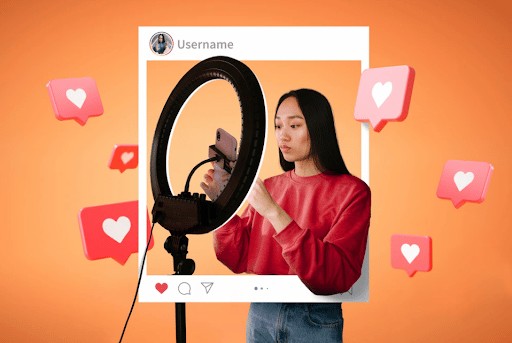One of the more difficult tasks is to measure influencer marketing ROI. It is easy to pay an endorser for something and know what those costs are. But it is difficult to know how much value you are getting for your money. In this article, we will show you an easy way to navigate this task.
What is Influencer Marketing ROI?
Influencer marketing is a type of social media marketing that involves endorsements and product placements from influencers. A good example is a well-known gamer endorsing another application that gives away rewards that can be used on the game he/she is playing.
ROI stands for return on investment. Simply compares the profit that resulted from a digital marketing campaign to how much the campaign cost to create and deploy. Ideally, you want as high an ROI as possible.
The basic ROI calculation is: ROI = (Net Profit/Total Cost)*100.
Why do you need to measure influencer marketing return on investment?
It is important to measure your influencer marketing return on investment to make sure you are reaching your target audience effectively and within your budget. With influencer marketing, you can find a lot of inconsistent line item influencer marketing costs. The rate of individual influencers is liable to change. Thus it isn’t always easy to know what a campaign is costing your company.
You need to prove that your spending has tangible revenue attached to it. You must ask what the company is getting in return for that spend. This is important not just for taxes, but also for business planning. In general, you’re to expect that the money spent on influencer marketing counts.
One of the great things about properly calculated ROI is that it helps you show how effective a campaign has been. If you find that a particular influencer marketing campaign has a very high return on investment, it is a reason for you to continue with that strategy. Likewise, an unprofitable campaign should be either adjusted or discontinued. Having effective ROI numbers allows you to make more money over time once you apply PDCA (Plan-Do-Check-Action) as part of a data-driven approach to influencer marketing across various marketing channels.
Influencer Metric ROI
Every business calculates ROI differently. But you’ve got to pinpoint your ideal metrics to calculate true ROI. A metric is just a measure of success. Ideally, metrics are hard numbers that are easy to track over time, but they can also be for less-tangible things like brand awareness and customer loyalty.
- 90% of influencer marketing programs track engagement as a metric.
- Most marketers track clicks (59%), impressions (55%), and conversions (54%) in their campaigns.
List of potential metrics to help you choose a few valuable data points:
- Likes
- Views
- Followers
- Engagement
- Shares
- Clicks
- Reactions
- New customer reach
- Referrals
- Reach
- Conversions
- Customer loyalty
- Impressions
- Sales/revenue
Also, keep your analytics in mind. Without proper analytics, you can’t track your metrics and you can’t determine your true ROI.

5 steps to calculate influencer marketing return on investment
- Set campaign goals
Running an influencer marketing campaign without a goal is pointless. Set a goal to create a more relevant campaign. Marketers who set goals are more likely to achieve success.
Ask questions like:
- What matters to your brand?
- What do you want to get out of your influencer relationships?
Then plan your goals such as:
- Engagement: Do you need people to comment on your blog or share your social posts?
- Return on ad spend: Do your ad creatives need a little kick? Use that user-generated content in your ads!
- Direct revenue: Do you straight-up need to stuff your coffers? There’s no shame in doing influencer marketing for the dollar bills, fam.
- Visibility: Do you want brand awareness? Positive Brand Affinity?
- Content creation: Do you need more awesome content for your website or social media?
Align this campaign goal with your larger marketing and organizational goals before pressing forward.
- Define your metrics
A goal puts you in the right direction, however, KPIs and metrics will get you to the finish line. Use the S.M.A.R.T. Framework to back up your goals with metrics. You need to build separate metrics for different influencers.
Consider tracking metrics like:
- Number of new customers
- Overall earnings
- Instagram post impressions
- Return on ad spend with creator-generated content
- Landing page visits (give each influencer a unique URL to track this)
- Engagement rates
Select your success metrics in the designing phase. When it’s time to extend to influencers, you can explicate how, in particular, you’ll measure success.
- Add your costs
To realize if this influencer marketing strategy was worth it, you have to know what it cost you.
Depending on your campaign, you could see costs like:
- Influencer fees: Depending on the influencer, you could pay a few hundred to several thousand dollars for a campaign.
- Software: You can streamline the entire process (and often eliminate these other costs) by going for an influencer marketing network. Some platforms, like the trend, minimize your costs in time and influencer fees.
- Time: Time is money, after all. The more time spent vetting influencers and managing your campaign, the higher the cost. Time can even be creating the content yourself versus using creators. Time-tracking software can help you quantify this.
- Product samples: Freebies might be free for influencers, but they aren’t free to you.
Try tracking campaign costs as you go. You can sum up everyone’s hours and costs at the end of the week and track it in your marketing software. On average, you can expect to pay an influencer per follower they have. Do not fail to recall the less-tangible costs involved in making your campaign shine.

- Calculate returns
These are your influencer marketing attainments. Depending on your objectives, there are a few ways to calculate your returns.
Brand awareness ROI
- Impressions or views
- Shares
If you have staggering data models already, you can appoint a dollar value to each impression. This varies by social platform, too. If you know that your impressions average out to a worth of $0.012 per impression, multiply that by your total impressions. That will give you a dollar amount you can measure once the campaign ends.
Engagement ROI
What’s an engagement worth to your business? We can measure that in terms of:
- Video views
- Comments
- Landing page visits
- Any other brand interaction that isn’t a purchase
Based on how much you’ve earned in the past from these engagements, what is one engagement worth? If you average $0.10 per engagement, multiply your total number of engagements by $0.10. That should give you an idea of your returns.
Return on ad spend ROI
Since ads featuring UGC receive 4x more clicks, you can’t afford to try this out.
We can then look at how those ads perform based on:
- Cost per click
- Cost per acquisition
- Return on ad spend
- And more!
Boosting your return on ad spend can be an immense benefit for enhancing your margins on ads. Don’t underestimate the value of creativity.
Direct sales ROI
Everybody loves money in the bank. Direct sales are the easiest way to calculate ROI. You’re looking at metrics like:
- Cost per acquisition
- Revenue
- Average order value
Brands measure this through affiliate links, promo codes, and Google Analytics. However you track it, make sure the dollars earned through influencer marketing are separate and distinct from your other initiatives.
- Analyze your results
If you spent $10,000 on influencer marketing and generated $20,000 in profit, that would look like this:
($20,000 / $10,000) X 100 = 200% ROI
As long as you can quantify your costs and returns, you can quantify ROI. It’s not a perfect science, but it should give you boss-appeasing numbers to justify future influencer marketing campaigns.
Influencer Marketing Measuring
How to measure the ROI of influencer marketing campaigns?
First, you must know the total sales results of your influencer marketing campaign. You can also calculate the ROI (return on investment).
To do this, you need to subtract the influencer cost from the generated profit, and then divide this new number by the cost of the investment.
Influencer ROI = (generated profit – influencer marketing cost) / influencer marketing cost.

Influencer Marketing KPI
By now you already have an idea about influencer marketing. Now, what is KPI? KPI stands for Key Performance Indicator.
Influencer marketing KPIs are calculable measurements that indicate if you’re reaching your influencer goals. Typically, you keep tabs on these indicators to see if your key performance is growing, declining, or changing. It can also indicate the progress of your marketing strategies. Common KPIs include conversion rate, follower growth, referral rate, sales rate, and more.
9 influencer marketing key performance indicators to track
- Followers – it is important to track followers because it can show how many you’re able to reach and influence your brand.
- Comments – Comments typically indicate engagement and interaction with your profile. Usually, the more comments there are on a post, the more successful its performance is.
- Referral traffic – it is the number of people that visits your social media page by clicking on it through an outside source. It is important to track this because it shows how effective other platforms are in promoting your brand, and which platform is sending more traffic to you
- Conversions – this refers to the generation of sales through your influencer marketing project. For example, if an influencer posts content on his/her social media page promoting your company’s product, and a follower purchases the product, this is a conversion. This is a key performance indicator that can be critical to track, as it shows your sales success.
- Engagement rate – in tracking your engagement rate and numbers, you must consider these things:
- Like – the total number of likes your post received.
- Reactions – the total number of engagements your post received.
- Shares – the number of times people shared your post to other platforms or directly to other people’s accounts.
- Comments – the total number of comments your post received.
- Mentions – the number of times people mentioned your product in their platforms, comments, or posts.
- Clicks – the number of times your company’s profile generates a click, indicating a social media user’s interest in seeing your content on your social media profile or website.

- Follower base growth rate
This tells you if new audiences are liking and sharing your content. Brands seeking to partner with influencers often prefer to do so if the influencer can demonstrate their ability to organically grow their audience.
- Website traffic – if your company has an e-commerce store, it can be beneficial to track its traffic rate. Increased traffic to your website can expand the likelihood of people making purchases from it. Hosting websites sometimes offer analytics dashboards that display how your website is performing in terms of traffic. These dashboards may also provide information about how your customers are arriving at your site, which can give you more information about referral traffic.
- Brand awareness and reach – this can give you insights into how many social media users are aware of you and how much influence you have on a platform.
- Content production – keeping track of these contents helps you ensure that your partnership agreement with an influencer is being fulfilled.
Influencer Marketing Tools
Influencer marketing tools help you determine your campaign performance.
- Social media analytics tool – Ex.: Google Analytics
- Social listening tools – Ex.: AgoraPulse
- Specialized tools – Ex.: SumoBuzz
Conclusion
Influencer marketing is a good way to boost and endorse your business. But you have to keep in mind you need to invest money in influencers, so you need to know what’s working for you,
The best way to spend your marketing budget wisely is by calculating your influencer marketing return on investment. You should know what matters to you. And finally, determine which platforms, influencers, and tools will assist you across to get to your desired marketing goal.
Despite it all, if you are still confused, try partnering with a trusted influencer marketing platform like Tanke.

